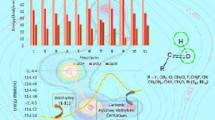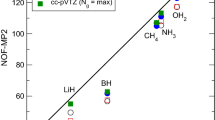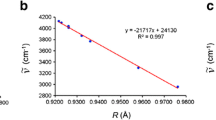Abstract
Although methyl transfer reactions are important in both chemical and biological systems, there is a need for thermodynamic parameters related to methyl affinity and O–CH3 bond dissociation enthalpies (BDEs) relevant to a full understanding of the mechanisms of methyl transfer reactions. As a prelude to the construction of a database of O–CH3 BDEs, the present work examines the reliability of a series of theoretical methods for the prediction of O–CH3 BDEs using a set of 25 compounds that included both aromatic and non-aromatic molecules. The BDEs calculated by density functional theory (DFT) with traditional exchange–correlation functions exhibited much larger errors than those obtained by either the M06-2X or G4 methods. For the non-aromatic compounds, M06-2X/def2-TZVP performed slightly better than G4, but G4 was more accurate for the aromatic molecules. As a result, we recommend G4 as the preferred method for the theoretical estimation of O–CH3 bond dissociation enthalpies, although M06-2X may be a good alternative for large complex molecules when the use of G4 is impractical.



Similar content being viewed by others
References
Luo Y-R (2002) Handbook of bond dissociation energies in organic compounds, 1st edn. CRC Press, Boca Raton
Izgorodina EI, Coote ML, Radom L (2005) Trends in R–X bond dissociation energies (R = Me, Et, i-Pr, t-Bu; X = H, CH3, OCH3, OH, F): a surprising shortcoming of density functional theory. J Phys Chem A 109(33):7558–7566
da Silva G, Chen CC, Bozzelli JW (2006) Bond dissociation energy of the phenol O–H bond from ab initio calculations. Chem Phys Lett 424(1–3):42–45
da Silva G, Kim CH, Bozzelli JW (2006) Thermodynamic properties (enthalpy, bond energy, entropy, and heat capacity) and internal rotor potentials of vinyl alcohol, methyl vinyl ether, and their corresponding radicals. J Phys Chem A 110(25):7925–7934
Black G, Curran H, Pichon S, Simmie J, Zhukov V (2010) Bio-butanol: combustion properties and detailed chemical kinetic model. Combust Flame 157(2):363–373
Fu Y, Liu R, Liu L, Guo QX (2004) Solvation effects of H2O and DMSO on the O–H bond dissociation energies of substituted phenols. J Phys Org Chem 17(4):282–288
Ghule VD, Sarangapani R, Jadhav PM, Tewari SP (2011) Theoretical studies on nitrogen rich energetic azoles. J Mol Model 17:1507–1515
Zhao J, Zeng H, Cheng X (2012) Bond dissociation energies for removal of the hydroxyl group in some alcohols from quantum chemical calculations. Int J Quantum Chem 112(3):665–671
Oyeyemi VB, Keith JA, Carter EA (2014) Trends in bond dissociation energies of alcohols and aldehydes computed with multireference averaged coupled-pair functional theory. J Phys Chem A 118(17):3039–3050
Hou A, Zhou X, Wang T, Wang F (2018) Fixed-node diffusion quantum Monte Carlo method on dissociation energies and their trends for R–X bonds (R = Me, Et, i-Pr, t-Bu). J Phys Chem A 122(22):5050–5057
Nam PC, Van QV, Thong NM, Thao PTT (2017) Invited review. Bond dissociation enthalpies in benzene derivatives and effect of substituents: an overview of density functional theory (B3LYP) based computational approach. Vietnam J Chem 55(6):679
Qu X, Latino DARS, Aires-de-Sousa J (2013) A big data approach to the ultra-fast prediction of DFT-calculated bond energies. J Cheminform 5(1):34
Chan B, Radom L (2012) BDE261: a comprehensive set of high-level theoretical bond dissociation enthalpies. J Phys Chem A 116(20):4975–4986
Li L, Fan HJ, Hu HQ (2016) Assessment of contemporary theoretical methods for bond dissociation enthalpies. Chin J Chem Phys 29(4):453–461
O’Reilly RJ, Karton A, Radom L (2012) N-H and N-Cl homolytic bond dissociation energies and radical stabilization energies: an assessment of theoretical procedures through comparison with benchmark-quality W2w data. Int J Quantum Chem 112(8):1862–1878
O’Reilly RJ, Karton A (2016) A dataset of highly accurate homolytic N–Br bond dissociation energies obtained by means of W2 theory. Int J Quantum Chem 116(1):52–60
Kosar N, Ayub K, Gilani MA, Mahmood T (2019) Benchmark DFT studies on C–CN homolytic cleavage and screening the substitution effect on bond dissociation energy. J Mol Model 25(2):47
Kosar N, Mahmood T, Ayub K (2017) Role of dispersion corrected hybrid GGA class in accurately calculating the bond dissociation energy of carbon halogen bond: a benchmark study. J Mol Struct 1150:447–458
Boal AK, Grove TL, McLaughlin MI, Yennawar NH, Booker SJ, Rosenzweig AC (2011) Structural basis for methyl transfer by a radical SAM enzyme. Science 332(6033):1089–1092
Struck AW, Thompson ML, Wong LS, Micklefield J (2012) S-Adenosyl-methionine-dependent methyltransferases: highly versatile enzymes in biocatalysis, biosynthesis and other biotechnological applications. ChemBioChem 13(18):2642–2655
Thayer JS, Brinckman FE (1982) The biological methylation of metals and metalloids. Adv Organomet Chem 20:313–356
Thayer JS (2002) Biological methylation of less-studied elements. Appl Organomet Chem 16(12):677–691
Cedar H, Bergman Y (2009) Linking DNA methylation and histone modification: patterns and paradigms. Nat Rev Genet 10(5):295
Schubeler D (2015) Function and information content of DNA methylation. Nature 517(7534):321–326
Robertson KD (2005) DNA methylation and human disease. Nat Rev Genet 6(8):597–610
Shen L, Song C-X, He C, Zhang Y (2014) Mechanism and function of oxidative reversal of DNA and RNA methylation. Annu Rev Biochem 83:585–614
Hamdane D, Grosjean H, Fontecave M (2016) Flavin-dependent methylation of RNAs: complex chemistry for a simple modification. J Mol Biol 428(24):4867–4881
Mannisto PT, Kaakkola S (1999) Catechol-O-methyltransferase (COMT): biochemistry, molecular biology, pharmacology, and clinical efficacy of the new selective COMT inhibitors. Pharmacol Rev 51(4):593–628
Jianyu Z, Klinman JP (2011) Enzymatic methyl transfer: role of an active site residue in generating active site compaction that correlates with catalytic efficiency. J Am Chem Soc 133(43):17134–17137
Jianyu Z, Kulik HJ, Martinez TJ, Klinman JP (2015) Mediation of donor-acceptor distance in an enzymatic methyl transfer reaction. Proc Natl Acad Sci USA 112(26):7954–7959
Wu-Yang H, Yi-Zhong C, Yanbo Z (2010) Natural phenolic compounds from medicinal herbs and dietary plants: potential use for cancer prevention. Nutr Cancer 62(1):1–20
Jursic BS (1998) Complete basis set ab initio computational study of unimolecular decomposition of dimethyl ether. Chem Phys Lett 295(5–6):447–454
Chandra A, Uchimaru T (2002) The OH bond dissociation energies of substituted phenols and proton affinities of substituted phenoxide ions: a DFT study. Int J Mol Sci 3(4):407–422
Pratt DA, de Heer MI, Mulder P, Ingold KU (2001) Oxygen-carbon bond dissociation enthalpies of benzyl phenyl ethers and anisoles. An example of temperature dependent substituent effects. J Am Chem Soc 123(23):5518–5526
Ding LL, Zheng WR, Wang YX (2015) Theoretical study on homolytic C(sp(2))-O cleavage in ethers and phenols. New J Chem 39(9):6935–6943
Frisch MJ, Trucks GW, Schlegel HB, Scuseria GE, Robb MA, Cheeseman JR, Scalmani G, Barone V, Petersson GA, Nakatsuji H, Li X, Caricato M, Marenich AV, Bloino J, Janesko BG, Gomperts R, Mennucci B, Hratchian HP, Ortiz JV, Izmaylov AF, Sonnenberg JL, Williams-Young D, Ding F, Lipparini F, Egidi F, Goings J, Peng B, Petrone A, Henderson T, Ranasinghe D, Zakrzewski VG, Gao J, Rega N, Zheng G, Liang W, Hada M, Ehara M, Toyota K, Fukuda R, Hasegawa J, Ishida M, Nakajima T, Honda Y, Kitao O, Nakai H, Vreven T, Throssell K, Montgomery JA, Jr, Peralta JE, Ogliaro F, Bearpark MJ, Heyd JJ, Brothers EN, Kudin KN, Staroverov VN, Keith TA, Kobayashi R, Normand J, Raghavachari K, Rendell AP, Burant JC, Iyengar SS, Tomasi J, Cossi M, Millam JM, Klene M, Adamo C, Cammi R, Ochterski JW, Martin RL, Morokuma K, Farkas O, Foresman JB, Fox DJ (2016) in Gaussian 09, Revision A.02, Gaussian, Inc., Wallingford CT
Becke AD (1993) Density-functional thermochemistry. 3. The role of exact exchange. J Chem Phys 98(7):5648–5652
Zhao Y, Truhlar DG (2008) The M06 suite of density functionals for main group thermochemistry, thermochemical kinetics, noncovalent interactions, excited states, and transition elements: two new functionals and systematic testing of four M06-class functionals and 12 other functionals. Theor Chem Acc 120(1–3):215–241
Yanai T, Tew DP, Handy NC (2004) A new hybrid exchange–correlation functional using the Coulomb-attenuating method (CAM-B3LYP). Chem Phys Lett 393(1–3):51–57
Chai J-D, Head-Gordon M (2008) Systematic optimization of long-range corrected hybrid density functionals. J Chem Phys 128(8):084106
Frisch MJ, Head-Gordon M, Pople JA (1990) A direct MP2 gradient method. Chem Phys Lett 166(3):275–280
Grimme S (2003) Improved second-order Moller–Plesset perturbation theory by separate scaling of parallel- and antiparallel-spin pair correlation energies. J Chem Phys 118(20):9095–9102
Jung YS, Lochan RC, Dutoi AD, Head-Gordon M (2004) Scaled opposite-spin second order Moller–Plesset correlation energy: an economical electronic structure method. J Chem Phys 121(20):9793–9802
Curtiss LA, Redfern PC, Raghavachari K (2007) Gaussian-4 theory. J Chem Phys 126(8):084108
Schäfer A, Horn H, Ahlrichs R (1992) Fully optimized contracted Gaussian basis sets for atoms Li to Kr. J Chem Phys 97(4):2571–2577
Weigend F, Ahlrichs R (2005) Balanced basis sets of split valence, triple zeta valence and quadruple zeta valence quality for H to Rn: design and assessment of accuracy. Phys Chem Chem Phys 7(18):3297–3305
Grimme S (2006) Semiempirical GGA-type density functional constructed with a long-range dispersion correction. J Comput Chem 27(15):1787–1799
Creary X (2006) Super radical stabilizers. Acc Chem Res 39(10):761–771
Acknowledgements
JZ is thankful for the financial support from National Natural Science Foundation of China (NSFC 21772143), the Natural Science Foundation of Tianjin (17JCYBJC42200), Tianjin Youth 1000-Plan Talent Program and Startup Funding of Tianjin University. Generous support by the School of Pharmaceutical Science and Technology, Tianjin University, China, including computer time on the SPST computer cluster Arran is gratefully acknowledged.
Author information
Authors and Affiliations
Corresponding authors
Additional information
Publisher's Note
Springer Nature remains neutral with regard to jurisdictional claims in published maps and institutional affiliations.
Electronic supplementary material
Below is the link to the electronic supplementary material.
Rights and permissions
About this article
Cite this article
Du, T., Quina, F.H., Tunega, D. et al. Theoretical O–CH3 bond dissociation enthalpies of selected aromatic and non-aromatic molecules. Theor Chem Acc 139, 75 (2020). https://doi.org/10.1007/s00214-020-02592-1
Received:
Accepted:
Published:
DOI: https://doi.org/10.1007/s00214-020-02592-1




